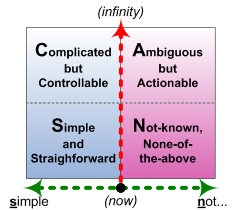Using recursion in sensemaking
This was such a good question from Paul Beckford, in one of his comments on the previous post, that I thought it was worthwhile bringing it out into more accessible form here:
“I don’t understand the recursion you speak of and the real time nature of decision making and how that is different from ‘considered’ decision making.”
I’ll deal with the easy bit first: real-time versus ‘considered’. Let’s use a really simple (and, at present, topical) example: New Year’s Resolutions.
- Did you make any New Year’s Resolutions? If you did, that’s a ‘considered’ decision, at some distance from the point of action – an intent.
- Assuming you did make a New Year’s Resolution, did you actually keep to it, in terms of what you actually do and did? – because that’s a real-time decision.
Given the above, notice how well (or not) the ‘considered’ decision-making lines up with the actual decisions made at the point of action. Overall, that’s an important part of enterprise-effectiveness. That’s what I’ve been working on, with the SCAN posts and the like.
[There’s also how review-processes such as PDCA and After Action Review etc link up with all of this: how the review of what we intend versus what we actually did is used to challenge and re-align the linkage between what we intend and what we do next time. If there is a ‘next time’, of course: it gets even trickier if there isn’t… 🙂 ]
The other point: recursion. For this context, recursion occurs when we use a framework on itself, to review or work with or refine itself. Let’s use the just the sensemaking side of the SCAN frame for this, it should (I hope!) be a safe and uncontroversial example.
So, we would say that this frame has four domains:
- Simple
- Complicated
- Ambiguous
- Not-known, None-of-the-above
And the boundaries of those domains are defined by two axes:
- horizontal: modality – true/false on left, uncertain (‘possibility/necessity’) on right
- vertical: distance in time (or time-available-until-irrevocable-decision) – from point-of-action to potentially-infinite time-available
At first glance, that’s a really simple categorisation. Note the word ‘Simple‘.
Then we notice that our Simple categorisation starts to get Complicated. The boundaries between the domains aren’t as fixed as they might at first seem: although there’s a definite ‘bump’ on the horizontal axis (what I’ve termed the ‘Inverse-Einstein test’), it’s actually a continuous spectrum of modality, from predictable to somewhat-variable to a lot of variation to everything inherently-unique with no pattern at all.
[The Inverse-Einstein test: on the ‘order’ side (Simple/Complicated), if we do the same thing, we expect to get the same result; on the ‘unorder’ side (Ambiguous/None-of-the-above), if we do the same thing, we may get a different result, or we may need to do different things in order to get the same result.]
And the vertical axis is always a completely continuous spectrum: there is a clear transition somewhere, between the ‘Newtonian’ (Complicated/Ambiguous) and ‘quantum’ (Simple/Not-known) levels, but we can’t define explicitly where it is.
Then our Simple-but-also-Complicated categorisation starts to get Ambiguous as well: we’ll see this especially when we use cross-maps, such as that one about skill-levels, where each skill-level represents a different mix of ‘order’ or ‘unorder’, again with no clear boundaries, and with a fair few emergent-properties arising as well.
And then we recognise also that there are aspects in this Simple-and-Complicated-and-Ambiguous categorisation that are inherently-unique, scattered all the way through everything we’re looking at, with some bits that are definitely Not-known or None-of-the-above. (In fact that’s the whole point of this kind of exploration, trying to make sense of those Not-known items and come to some useful actionable decisions about them.)
And, yes, once we dig deeper, we’ll find that the same kind of pattern recurs at another level, and then deeper again, and so on.
Fractal, self-similar, recursive; Simple, Complicated, Ambiguous, None-of-the-above, all of them weaving through each other, all at the same time.
That’s what I mean by recursion here: the framework used to explore itself, and explore the exploring of itself, and – of course – of what it is itself being used to explore.
Makes sense? I hope? 🙂

http://bptrends.com/deliver_file.cfm?fileType=publication&fileName=FIVEA11%2D02%2D10%2DART%2DSocialMediaandSocialCompanies%2Dvanderreep%2Dfinal%5D%2Epdf
This article (link) defines recursion as a prerequisite for software in the social company. Recursion allows me to relate my contribution to the bigger picture. Awareness of context fosters the sense of meaningful action: why you do someting…
Did you take steps in this Tom?
I think the topic is important enough. In anthrpology they calim that all viable (social) systmes0 are recursive in nature as non recursivity leads to fragmentation ( which ‘managment’should solve of course).
http://www.managementsite.com/512/Social-Companies-part-two.aspx
Hi Frans
I strongly agree with what you say about the mandatory nature of recursivity, but “take steps” in what sense? I don’t understand… what do you suggest I should I do about this, and where?